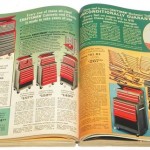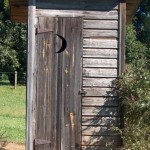“The Ultimate Recyclable”
Posted byDec 1
The Ultimate Recyclable
By Jake Jakubuwski
Copyright, 2011
There’s no question in my mind that today “things” are different then when I was a kid. I’m not saying they are better, or worse, just different.
A couple of times a week, I do a coffee klatch with a bunch of other “old” guys who remember twenty-five-cent-a-gallon gasoline and nickel candy bars. One thing I’ve noticed is that all of them seem to think that if we could just get the country back to what it was like right after WWII, everything would be just dandy — again.
As much as I hate to burst their bubble — it ain’t gonna happen. But on the flip side that’s not all bad either.
In the late 40s and early 50s I can remember unpaved streets and outhouses within the city limits of Baltimore. I remember my grandfather’s house inGlen Burnie, Maryland having an outhouse. Indoor facilities consisted of a “chamber pot” that was slid under the bed for use during the night! We also had a hand-pump under the grape arbor where we “drew” our water for cooking, drinking and bathing — year around.
I surely don’t want to go back to living like that. On the plus side, there were not as many automobiles on the roads and streets back then, so the streets were our playground. If we had a game of stick ball going, widely spaced cars, light poles and “ash” cans were home plate and bases. You made do with what you had to do with.
One thing we did have that we don’t have today was the ultimate recyclable: The Sears Roebuck catalog! Man, that book got used, reused and used up!
Way back before my time, the Sears Catalog sold cars, tractors and even “Modern House Kits”. You could buy garden equipment, groceries, yard goods, shoes, lamps, auto parts, tires, and thousands of other items that just made you look through the catalog for hours and hours and hours wishin’ you had a pocket full of money or, fewer dreams.
By the time I could peruse the Sears catalog, cars, tractors and housing kits were bygones. But it was still a book chock full of things that could be had a little cheaper the in a regular store and your “Satisfaction” was “Guaranteed”. Not only was the catalog a great way to shop — especially if you lived in a rural area where there were no such thing as malls or even “Department” stores — it was also great entertainment.
We could spend hours looking at bicycles, wagons, Red Ryder BB guns and other things that we kids thought we could not live without but might never own.
I think some of us kids sharpened our reading and math skills with the Sears Catalog. We could look at the price of an item, calculate the shipping and figure out how much we’d have to save over how long a period of time it we wanted to buy new galoshes, a Red Ryder BB gun, a Roy Rodgers hat or a new Schwinn.
I know the Sears Catalog helped me become a better reader — I was always finding new words that I didn’t know, like: ”guaranteed” and “duvet”. I remember my grandmother taking the catalog away from me when I asked her how to pronounce “l-i-n-g-e-r-i-e”. She swatted me upside the head and told me I wasn’t to look in that section of the catalog anymore!
I imagine her admonition probably kept me out of that section of the catalog for a good ten minutes. And, even then, I never looked “in that section” after that unless I was sure there were no adults around or I was by myself in the outhouse. I know that in today’s advertising world seeing a lady in a bra is no big deal. Back then, before I was ten, those glossy photographs of ladies in their “unmentionables” was, well … unmentionable.
The Risqué Factor for pictures like that was high enough that some pre-adolescents had been known to tear those pictures out of the catalogs and show them to their friends in out-of-the-way corners of the school playground and cloak rooms. We didn’t have locker rooms back then because we didn’t have gyms. Regardless, speculation regarding what that lingerie covered was a hot topic back then.
Anyway, back to the more practical side of the “Ultimate Recyclable” aspects of the Sears Roebuck Catalog.
In my grandfather’s house, we lived in what today would be described as a “finished basement”. Back then it was a “cellar”. The floors had linoleum on them and we had an eat-in kitchen and a “parlor” where the radio was — TV was still several years away. My grandfather had a big “Easy” chair that set next to a pot-bellied stove and in the winter months, that’s where Pop stayed most of the time when he wasn’t working.
Every morning, Pop would come downstairs (The bedrooms were on the first floor) and build a fire in the pot-bellied stove. He’d tear a couple of pages out of the “old” catalog, crumple them up, lay a few pieces of kindling on them and light the pile with a kitchen match. When he was satisfied that he had a good start to his fire, he would put a small amount of coal on top of the kindling.
In the spring, when Pop planted his garden, he would use pages out of a catalog, along with newspapers to cover his seedlings and keep them warm and moist. He also used catalog sheets and newspaper as insulation in his tool shed.
I knew some folks that used the pages as shelf liners in their kitchen cabinets and pantries.
The glossy sheets (The ones found in the lingerie section) were really not suitable for anything but looking at (At least in my pre-teen mind) or lining shelves and covering seed beds. Judging from my memories of my peers comments, that section did get a lot of attention when they used the “facilities”.
However the newsprint pages that composed the rest of the catalog were ideal for completing the job we went to the outhouse to accomplish. If you ripped out a page and crinkled it up, it made a fairly good substitute for the toilet paper that we did not have. It was a little rough, but usable.
The glossy pages, on the other hand, just didn’t have the wipe-ability of the coarser pages. Besides, those were the pages that Pop was most likely to use in his seed beds — those pages apparently had better “dimensional stability” when they got wet. Pop didn’t use the term dimensional stability but he knew what he was doing.
Now you know why I considered the Sears Roebuck Catalog as being essential to America’s shoppers, gardeners, fire-starters, fledgling readers and mathematicians, nascent voyeurs and as an indispensible aid in helpingAmerica finish the job by being the paper that got the job done.
I truly consider the Sears Catalog (The last “BIG” book was printed in 1993) to have been the ultimate recyclable. From sales to sanitation that book did it all. I don’t miss it but I sure do remember it!
If you’re interested, this link:
(http://www.searsarchives.com/catalogs/history.htm)
will give you a pretty thorough history of the Sears Catalog and the changes it made in the buying habits of Americans. A lot of famous Americans were featured in its pages but for some reason, there’s no mention of the recyclability of that venerable old catalog as we used it.

